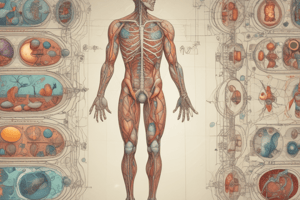Podcast
Questions and Answers
What is the definition of homeostasis?
What is the definition of homeostasis?
- The ability of an organism to maintain a stable internal environment despite changes in external conditions (correct)
- The ability of an organism to change its external environment
- The ability of an organism to adapt to changes in external conditions
- The ability of an organism to respond to changes in the internal environment
What is the primary function of receptors in homeostasis?
What is the primary function of receptors in homeostasis?
- To respond to changes in the internal environment
- To maintain a stable body temperature
- To detect changes in the internal environment (correct)
- To regulate blood sugar levels
Which of the following is an example of short-term homeostasis?
Which of the following is an example of short-term homeostasis?
- Regulation of blood sugar levels
- Adaptation to high altitude
- Regulation of body temperature
- Regulation of heart rate and blood pressure (correct)
What is the result of a homeostatic imbalance?
What is the result of a homeostatic imbalance?
Which of the following is an example of a negative feedback mechanism?
Which of the following is an example of a negative feedback mechanism?
What is the role of the control center in homeostasis?
What is the role of the control center in homeostasis?
Which of the following is an example of a long-term homeostatic response?
Which of the following is an example of a long-term homeostatic response?
What is the significance of homeostasis in maintaining overall health?
What is the significance of homeostasis in maintaining overall health?
Study Notes
Definition and Importance
- Homeostasis: the ability of an organism or system to maintain a stable internal environment despite changes in external conditions.
- Crucial for survival, as it allows the body to maintain optimal conditions for cellular functions.
Key Components
- Negative feedback mechanisms: responses to changes in the internal environment that counteract the change and restore balance.
- Receptors: sensors that detect changes in the internal environment.
- Effectors: organs or tissues that respond to changes and make adjustments to maintain homeostasis.
- Control center: the part of the brain that interprets information from receptors and sends signals to effectors.
Examples of Homeostasis
- Thermoregulation: maintaining a stable body temperature despite changes in environmental temperature.
- Shivering or sweating to regulate body temperature.
- Blood sugar regulation: maintaining a stable level of glucose in the blood.
- Insulin and glucagon hormones regulate blood sugar levels.
- Blood pH regulation: maintaining a stable acid-base balance.
- Buffers and respiratory system regulate blood pH.
Types of Homeostasis
- Short-term homeostasis: rapid responses to changes in the internal environment.
- Examples: heart rate and blood pressure regulation.
- Long-term homeostasis: slower responses to changes in the internal environment.
- Examples: adaptation to high altitude or changes in diet.
Homeostasis and Health
- Homeostatic imbalance: a state of disease or disorder.
- Examples: diabetes (blood sugar imbalance), hypertension (blood pressure imbalance), and acidosis (blood pH imbalance).
- Homeostasis is essential for maintaining overall health and preventing disease.
Definition and Importance of Homeostasis
- Homeostasis is the ability of an organism or system to maintain a stable internal environment despite changes in external conditions.
- It is crucial for survival, as it allows the body to maintain optimal conditions for cellular functions.
Key Components of Homeostasis
- Negative feedback mechanisms respond to changes in the internal environment and counteract the change to restore balance.
- Receptors are sensors that detect changes in the internal environment.
- Effectors are organs or tissues that respond to changes and make adjustments to maintain homeostasis.
- The control center, located in the brain, interprets information from receptors and sends signals to effectors.
Examples of Homeostasis
- Thermoregulation maintains a stable body temperature despite changes in environmental temperature through shivering or sweating.
- Blood sugar regulation maintains a stable level of glucose in the blood through insulin and glucagon hormones.
- Blood pH regulation maintains a stable acid-base balance through buffers and the respiratory system.
Types of Homeostasis
- Short-term homeostasis involves rapid responses to changes in the internal environment, such as heart rate and blood pressure regulation.
- Long-term homeostasis involves slower responses to changes in the internal environment, such as adaptation to high altitude or changes in diet.
Homeostasis and Health
- Homeostatic imbalance leads to a state of disease or disorder, such as diabetes (blood sugar imbalance), hypertension (blood pressure imbalance), and acidosis (blood pH imbalance).
- Homeostasis is essential for maintaining overall health and preventing disease.
Studying That Suits You
Use AI to generate personalized quizzes and flashcards to suit your learning preferences.
Description
Learn about the process of maintaining a stable internal environment in an organism, crucial for survival, and its key components.




